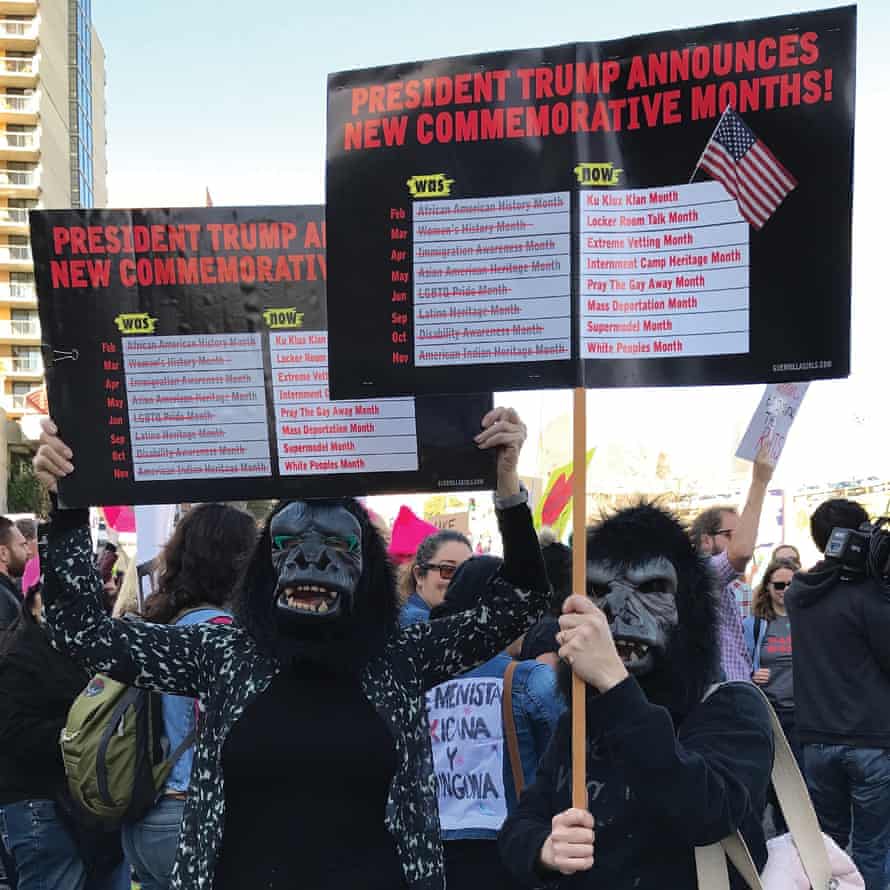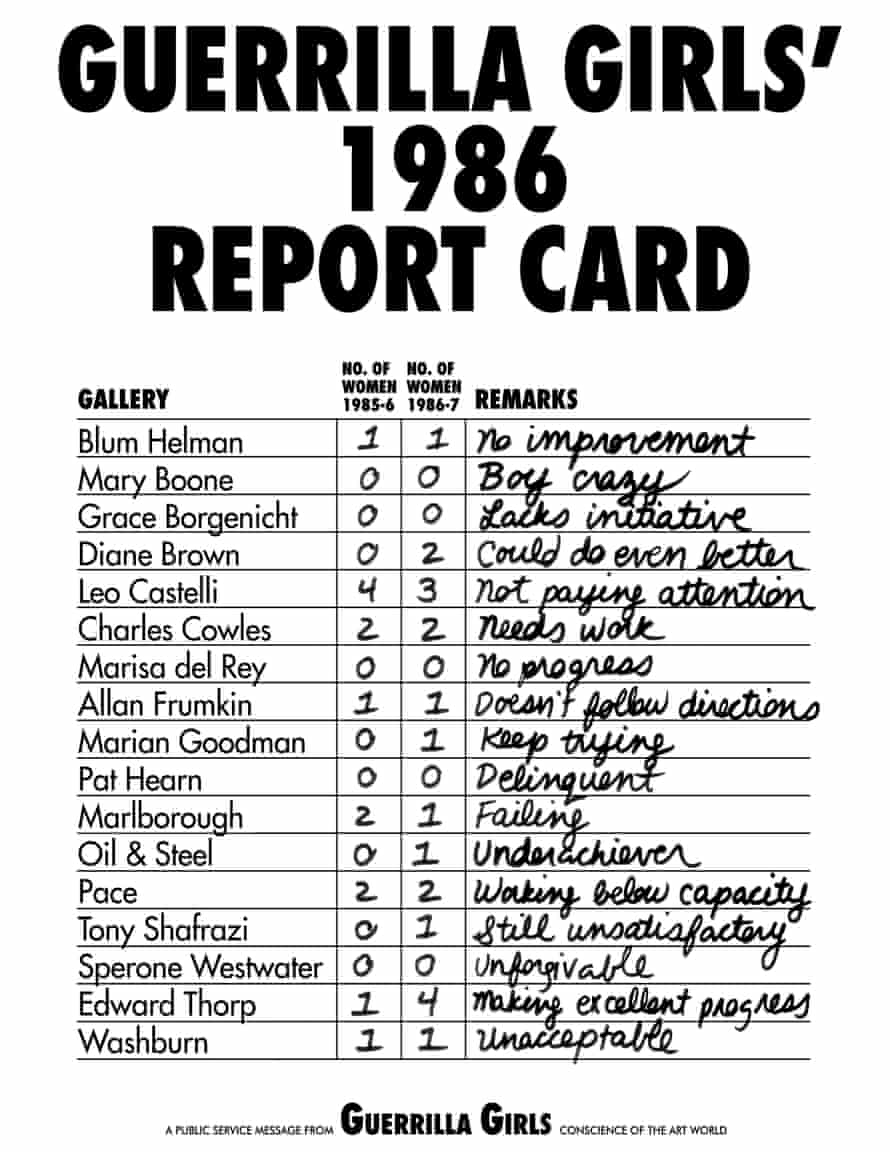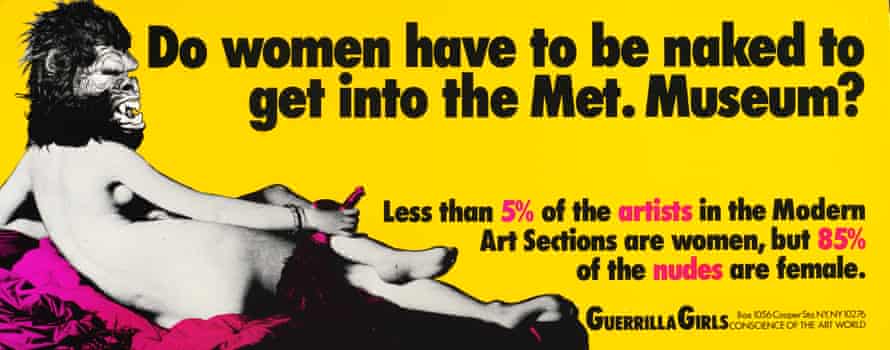They Usually Appreciate People Dead When Theyre in the Art World
I n 1984, a group of women in New York gathered outside the Museum of Modern Art as role of a protest. A group show, An International Survey of Recent Painting and Sculpture, was showing 165 artists, 152 male artists exhibited alongside but xiii women.
Outraged, they attended the protest, bringing placards and chanting outside the museum. But a handful of women within the larger crowd learned something.
"We realized it didn't work, nobody cared nigh what nosotros were maxim," creative person Käthe Kollwitz told the Guardian (each fellow member of the Guerrilla Girls takes the name of a dead female artist as a pseudonym). "Nosotros figured there had to exist a amend way of getting people's attending, to testify to people that the fine art world is non the meritocracy that everyone thought it was."
These women – and dozens more than – would afterward fuse forces to become a legendary DIY art group, making a career out of the art of protest.
They're called the Guerrilla Girls, a collective that has been active since 1985. But recently, they accept released a book, a retrospective of sorts, entitled Guerrilla Girls: The Art Of Behaving Badly, which features over 200 artworks past the group, who have pasted up thousands of feminist posters across the globe, with scathing bigotry statistics.
"We wanted to see all our piece of work together in ane book, nosotros oasis't done a volume similar this," said Kollwitz. "It'due south a journey through our artwork, the aforementioned issues and political fine art we've been doing since the outset in 1985."
The book attempts to rewrite fine art history that has erased female artists, likewise equally people of color, many of whom have been left outside of the art world canon – peculiarly when information technology comes to museums.

"Nosotros feel museums have a duty to tell the real story of art history, not simply the white male creative person part," said "Frida Kahlo", one of the group'south co-founders. "Our goal is always to twist an issue around and present it in a fashion, so you lot think almost it differently."
Their real names are clandestine and they habiliment masks, to "conceal their identities and focus on the problems, rather than their personalities", they write on their website.
Over the class of 35 years, more 100 women have joined their collective, creating poster paste-ups, billboards, protests, books and projects, all armed with a feminist bulletin, ane aimed to trigger social change. Sort of similar art earth superheroes, they call themselves "feminist masked avengers".
Their formula is equally such: "Writing a killer headline, using killer statistics and crazy visuals," said Kollwitz. "We really just kept on doing that. In time, it really has added up to something that has an effect."
It led to their early 1985 posters, which read: "How many women had one-person exhibitions at NYC museums last year?"
The Guggenheim, MET and Whitney were all listed scoring as "0", with the MoMA having a meager "1".

Another poster the aforementioned year, took a stab at commercial art galleries, listing those that show no more than 10% female artists (or none at all). "All hell broke loose," said Kollwitz. "From the time our first posters went up in 1985, information technology was a breath of fresh air for artists who were struggling and not getting any appreciation. Nosotros keep making problem, keep upending the art world's notions of what is good and what is right."
While the group has unveiled a nighttime side of art world, take they seen much change over the by 35 years? "It's always ii steps forward ane pace back," says Kollwitz. "The changes aren't great, but we are in a moment where museums are playing catch-up and collecting work by artists of color. That's a modify, but volition they stick with it? Many of their collections don't have people of color or women at all."
In a recent study, merely 11% of art acquired by America's pinnacle museums, between 2008 and 2018, was by female artists.
Why would artists be so afraid to brand trouble and speak upwards near this? "There's so few people who pull the strings, that's why," notes Kahlo. "It's a smaller place than you imagine when you climb that ladder."
Ane of the artworks in the book is a piece called the Guerrilla Girls' 1986 Study Card, which lists 17 gallerists and their representation of women artists. With cursive handwriting, each gallery is scrutinized for their lack of improvements in showing women artists.
"Diane Dark-brown: Could do fifty-fifty meliorate," they write like a quaternary-grade instructor, comparison each gallerist with their programming from the previous year.
"Mary Boone: Boy Crazy," noting that she showed zilch women artists over ii years.
"Pat Hearn: Delinquent," the note, post-obit the same pattern.
"Information technology was a parody of an elementary schoolhouse postcard," said Kollwitz, looking back. "We were always scolding the art globe, so here we are being the teachers, showing how poorly they were all doing."

Probably their most famous piece is a 1989 poster of a reclining nude woman wearing a gorilla mask, which asks: "Do women accept to be naked to get into the Met Museum?" detailing that: "Less than 5% of the artists in the modernistic fine art department are women, but 85% of the nudes are female."
In some other slice, a poster from 1990, their Guerrilla Girls pop quiz asks: "If Feb is blackness history month and March is women'south history month, what happens the rest of the yr?" The reply: "Discrimination."
They take focused on the fine art market for a reason. "The art world has become a market place-based place," Kahlo says. "We started going later museums, which are meant to be autonomous educational institutions, because that'due south where art collectors go to appreciate the value of their collections and buy influence, go insider trading and artwash their bad reputations by actualization to support civilisation."
The group has squarely focused on museum boards, something that has recently come up under burn, similar museums cut ties with the Sackler family, who have links to the ongoing opioid crisis, or the Whitney Museum of American Art's trustees board member Warren Kanders, who resigned last year after controversy effectually his connections to weapons manufacturing. More than recently, Tom Gores, a quondam board fellow member of the Los Angeles County Museum of Art resigned after information technology was revealed he invested in a telephone visitor that charges unregulated premiums to jail inmates.

"Information technology's a dark corner of the fine art globe," said Kahlo. "A lot of people giving money to boards don't make their money in nice ways. They manufacture weapons of land command, they push button opioid drugs, it's a huge trouble. They sit on museum boards to make it all expect good."
While many people on museum boards have been forced to resign due to the work of the Guerrilla Girls and other artist-activist protestation groups, like Decolonize This Identify and the Feminist Art Coalition, the group take been behind milestones in art history, aslope the Riot Grrrl move, Women Artists in Revolution, the Sister Serpents art grouping and the New York Feminist Art Found.
But unlike many others, they wanted to remain anonymous. "We wanted to create the idea that we are everywhere, and we are listening," said Kollwitz. "We could be working at the MoMA or even at Leo Castelli'due south gallery. Nosotros wanted to create this thought that the art world was being watched, surveilled and scrutinized. Anonymity has protected us, but now I'm not sure anyone cares whatever more who nosotros are. It has inverse."
What also has inverse is the office of the artist-activist, and the corporeality of resistance art that has sprung up under the Trump administration.
"Before, at that place was a lot of disbelief and animosity to anyone continuing upward to institutions and calling out discriminations," said Kollwitz.
"It's an amazing fourth dimension for activism," she adds. "In that location's so many activists in the political art and cultural realm, that we're all pushing progress forward and protesting all the horrible things that are happening."
-
Guerrilla Girls: The Fine art Of Behaving Badly is out now
Source: https://www.theguardian.com/artanddesign/2020/oct/19/the-guerrilla-girls-interview-art-world-rebels